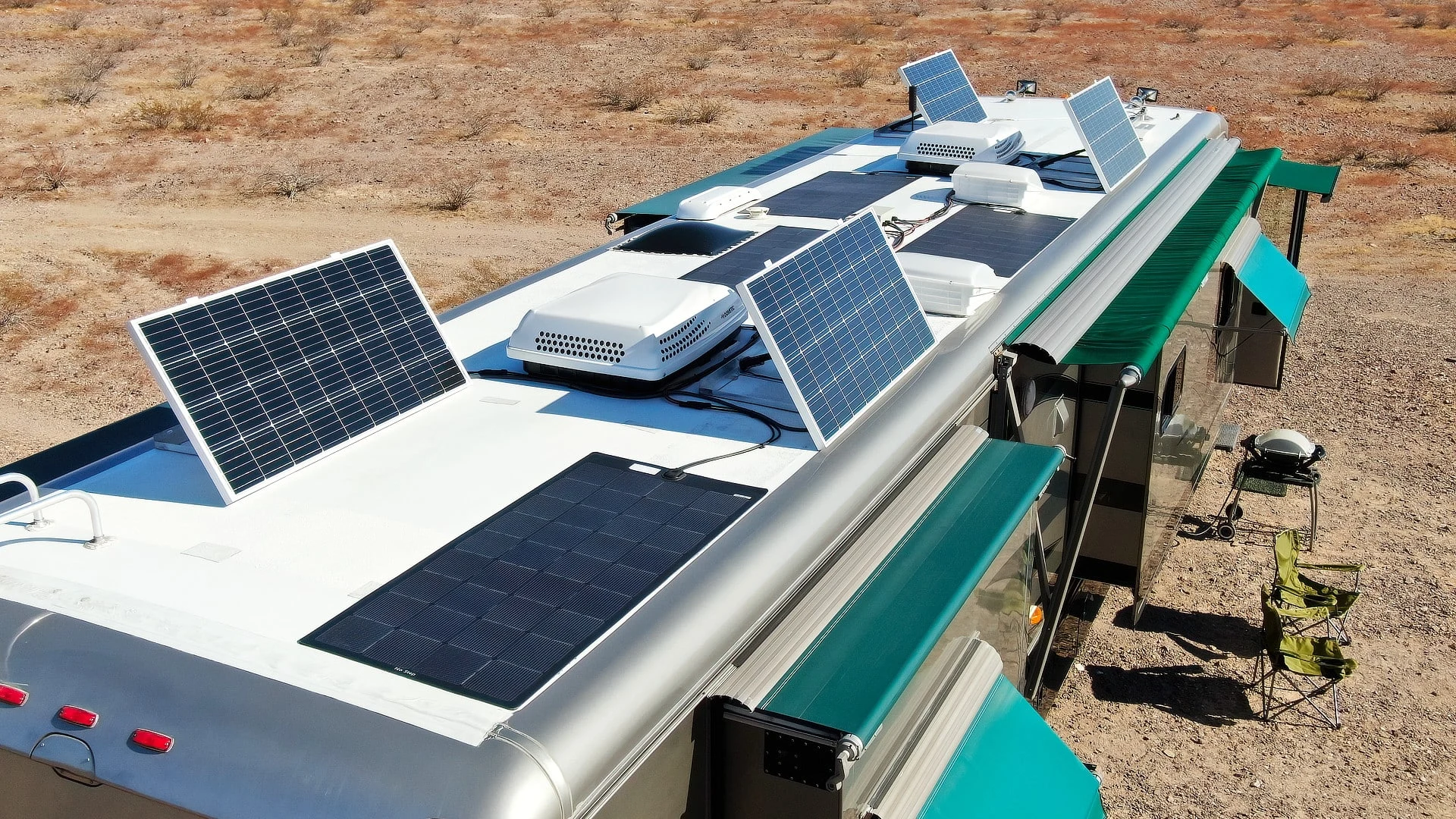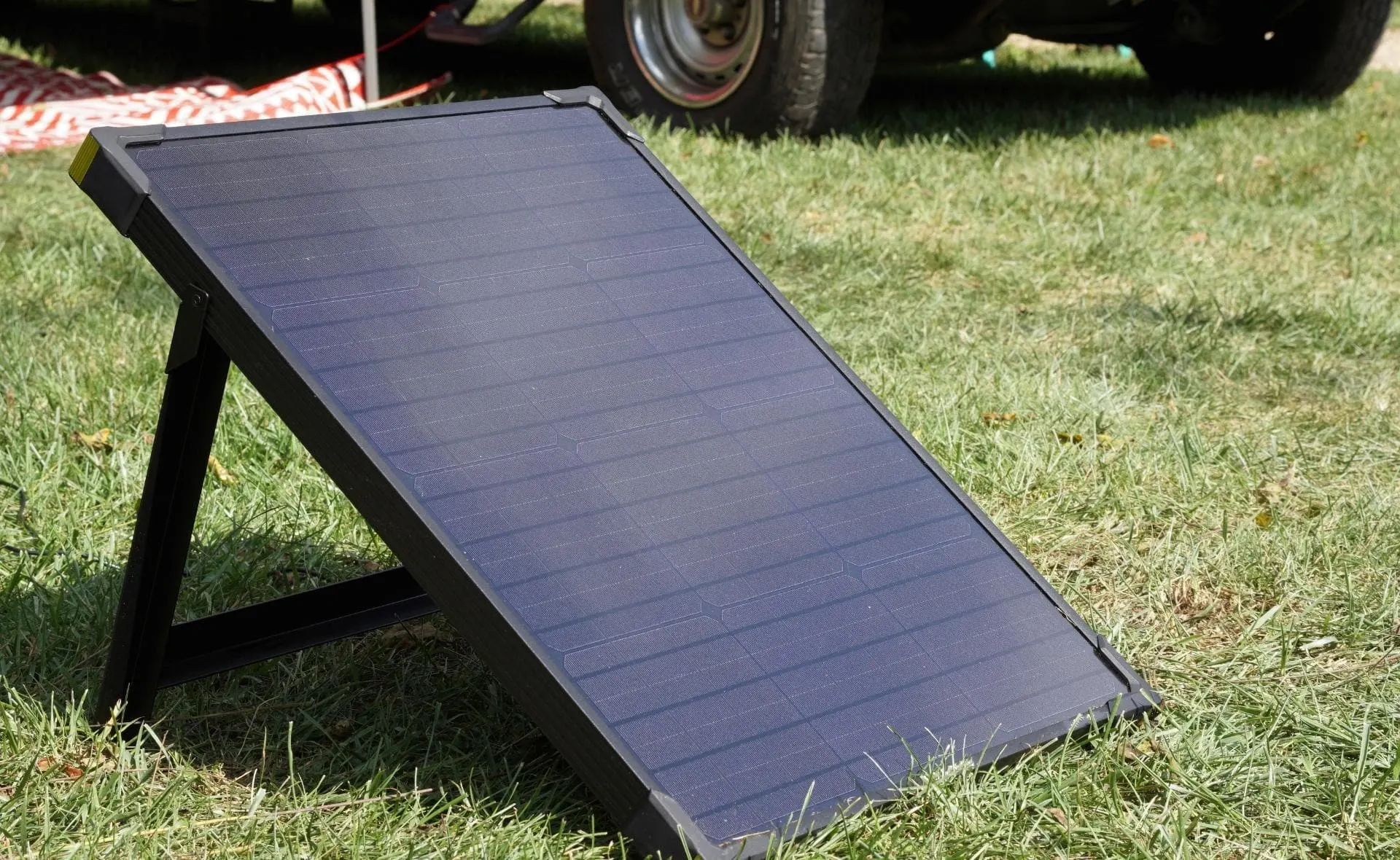As we write this post, we’re stepping into spring which means summer is right around the corner. We’re excited, and we know you are, too. But, one of the top questions RVers seek to answer when the hot weather rolls around is how to keep their RV cool and comfortable. So today, with time to spare, we’re lending you 20 years of summer RV living experience with our 11 tips for how to keep your RV cool this summer.
Before you get too hot, let’s jump right in!
- 1) Park In the Shade
- 2) Use Your Awnings
- 3) Open a Window and Run Your Roof Vent Fan
- 4) Use Interior/Personal Fans
- 5) Reflective Window Coverings
- 6) Leave Your RV
- 7) Use an Insulator When Not Running Your RV Vent Fan
- 8) Cook Outside
- 9) Upgrade to LED Lights/Bulbs
- 10) Stay Well Hydrated and Use Personal Cooling Items
- 11) Move Your Location
- 12) How Do You Stay Cool In the Summer Heat?
Park In the Shade
When possible, park your rig in the shade. Even if you’re running into a store or a restaurant, seek shade to keep your RV cooler, especially during the hottest part of the day.
Now – if you’ve got solar panels on your roof, this can be a bit tricky, because you don’t want to deprive those panels of the brightest sun of the day. That sun gives you the strongest energy, after all. So, you’ve got to weigh the issue and balance the needs for solar with the cool advantage of parking in the shade.
We take particular advantage of the sun when we tilt our panels as you may have seen in our post asking “Should I tilt my solar panels?”. We’ve been tilting our solar panels for years, and we’ve amassed plenty of evidence that it does indeed make a difference in the amount of power output solar can provide.

We have a fairly massive solar array and the ability to maximize our harnessing of the power of the sun by tilting half of our solar array accordingly.
Obviously, if your entire rig is parked in the shade and your solar panels aren’t exposed to the sun, nothing much makes a difference. So, again – it’s all about balance.
One option for parking in the shade to keep your RV cool, while still taking advantage of solar panels, is to use portable solar panels for your RV. This way, you can set your portable solar panels out in the sun, well away from the RV’s cooler spot beneath the shade trees.

Portable solar panels can be placed in direct sunlight while your RV is parked in the shade.
Either way, keeping the sun off as much as possible is a key way to keep your RV cool in the summer heat.
Use Your Awnings
Even if we can’t park our RV in the shade, we like to take advantage of our Tough Top awnings and privacy panel to keep the heat off the side of our RV. If you’ve got a patio awning, use it to shade the sunny side of your RV in the midday heat.
If you’ve also got RV window awnings (as we do), use those to your advantage as well. It’s amazing how much heat is deflected away from your RV when your awnings are deployed.
Open a Window and Run Your Roof Vent Fan
If you’ve never run your RV roof vent fan with a window or two open in the rig, you won’t believe how powerful this tip is as a means to keep your RV cool in summer.
Many RVers run a roof vent fan with an open window in the rig all summer to stay cool, and they barely need to use AC at all, (depending on their travel location, of course). This cools the RV amazingly well, but you’ve got to be sure to stay on top of any necessary maintenance of your roof vent fan. The last thing you want to do is head out on a camping adventure without a working vent fan.
So as we make our way toward summer, now’s a great time to check the condition of your RV roof vent fan. If you need to replace your fan, we’ve got you covered with our post on the 3 best RV roof vent fans, and our companion post offering step-by-step instructions for RV roof vent fan replacement.
This is a great DIY project if you’re comfortable working on your roof. As always, use caution on the roof, and make sure you have the tools and components you need on hand before you begin.
Be sure to also visit our post on how to install an RV roof vent cover, so that you can even operate your fan in the rain. Just because it’s overcast and raining out, doesn’t mean it’s not also hot (and, worse, MUGGY)!
If all your current RV vent fan needs is a good cleaning, follow along as we super-clean an RV Fantastic vent fan:
Use Interior/Personal Fans
Sometimes a personal fan, or an additional interior fan, may be all you need to keep cool in your RV, depending on your ability or desire to run your AC. A little wind can go a long way in a rig, and these fans have great reviews among RVers.
Sirocco II 12V/24V Fan
Caframo’s Sirocco and Sirocco II fans have been popular among RVers and van campers for quite some time. The amount of air these fans are capable of moving is reportedly impressive despite a low power consumption. To top it all off, they’re made in North America and come with a two-year warranty.
- 185 CFM on high (314 m³/hr), Current draw on low 0.06A (24V) and 0.12A (12V), Current draw on high 0.21A (24V) and 0.35A (12V).
- Unique gimbaled design allows complete 360° airflow with ultra quiet operation (54dB on high).
O2COOL Treva 10-Inch Portable Desktop Air Circulation Battery Fan, 2 Speed, Compact Folding & Tilt Design, with AC Adapter
This is a more personal, in-your-face kind of fan – something that could run directly on you either at your desk, kitchen table, or on your bedside table. The 10-inch blades are noted to push a fair amount of air, and two speeds are offered.
The fan folds for easy storage and works on battery power (6 D-cells) or via the AC adapter.
- BATTERY -OPERATED PORTABLE FAN. You can cool off when you’re at home, work or outdoors with O2COOL’s 10-Inch Battery-Operated Portable Fan....
- DURABLE CONSTRUCTION. Durably crafted using sturdy plastic construction for long-lasting strength and use, this portable fan boasts a patented fan...
Geek Aire 19,200mAh Rechargeable Battery Operated Floor Fan, Powered Fast Air Circulating Fan, Up to 30 Hours
This is a portable metal fan with 12-inch blades that runs on a rechargeable lithium-ion battery for up to 30 hours. It comes with a 26.5V power adapter that charges the fan in 2.5-3.5 hours.
Reviewers note that these fans push a powerful airflow and can be used outdoors. This one has the longest-lasting battery, but Geek Aire makes other versions of this fan including one with larger 16-inch blades to move more air.
- 【RECHARGEABLE FAN WITH POWER BANK FUNCTION】 Geek Aire 16'' Rechargeable Outdoor Fan is driven by a 15000mAh large battery which takes 2.5-3 hours...
- 【HIGH VELOCITY FAN WITH TILT FEATURE】 This battery powered fan possesses an adjustable 120°tilt head which directs movement more precisely to...
Reflective Window Coverings
Reflective windows coverings are great for keeping the heat of the sun from warming up things inside your RV. Many campers use Reflectix or a similar foil-over-bubble-wrap insulation material to construct window covers for every window in their rigs.
This product comes in a roll, and you can use paper to make patterns of your windows, and then cut the Reflectix to size, allowing for an extra ½ inch or so around the perimeter of each so it fits snugly in the window frame to stay in place. The insulation generally slips very easily into the window casing and holds there very well.
- Item Weight: 4.6 lb
- Country of Origin: China
Keeping the heat of the sun out of your RV as much as possible, whether by parking in the shade or insulating your windows, is a great way to keep your RV cool this summer.
Leave Your RV
One really great way to stay cooler in the midday heat of summer is to get out of your RV and explore the woods, beaches, creeks, rivers, streams, oceans, or any of the other attractions near where you’re camping.
Kayaking, paddleboarding, swimming, and hiking in the shade, are all fantastic activities that will not only feed the body and soul but also keep you away from the RV during the hottest part of the day.
Use an Insulator When Not Running Your RV Vent Fan
Insulating your vent fan when it’s not in use is very helpful in keeping both the heat of summer (and the cold of winter) from entering your RV. And if you have a skylight in your RV, insulating that opening from the sun is a very good idea when the weather’s hot, too. Skylights and roof vent fans don’t provide much insulation, so they’re a prime spot for the summer heat (or winter cold) to get inside.
These are a standard size, but be sure to measure the opening in your RV just to be sure it’ll fit. They’re not expensive, and they work well. Just push them up into the opening and you’re likely to see the interior temperature of your RV drop.
- RV VENT REFLECTIVE INSULATION: Camco’s vent insulator blocks the sun's damaging rays. It helps keep your RV cooler in the summer and warmer in the...
- SAVES ENERGY: This product reduces heat transfer and increases A/C efficiency.
Cook Outside
When it’s hot outside and you’re trying to keep your RV cool, using your indoor stove or oven will only make it hotter. Consider cooking outside when you’re camping in hot weather. If you’re connected to shore power (or have a generator you don’t mind running briefly or a large enough battery bank), you can also use your microwave to quickly heat up a meal. Or, you can simply choose to eat cold foods instead, and avoid generating ANY extra heat.
We really enjoy cooking outside, so we’ve set our rig up with an easy BBQ grill connection to our RV’s onboard propane tank. If you’d like to take a look at how we do this, feel free to have a look at our video:
Upgrade to LED Lights/Bulbs
LED lighting is one of the best investments you can make in your RV. Yeah, we know – it seems like an inconsequential thing. But it’s not. Not only will LED lighting save you LOTS of power (which is especially beneficial when you’re boondocking), but LED lights are also MUCH cooler than incandescent lights.
When you’re trying to keep your RV cool in the heat of summer, every little bit helps. To help, switch out your standard light bulbs/fixtures for LED lights, and you’re sure to notice a difference.
We’ve got a 6-part series beginning with Part 1 on the “how” and “why” to LED your RV, that you can follow all the way through. These are accompanied by our 6-part YouTube series on LED lighting, beginning with Part 1 right here:
Stay Well Hydrated and Use Personal Cooling Items
When you’re camping or participating in activities in the heat and humidity of summer, it’s particularly important to stay well hydrated. ALWAYS have water with you no matter where you are or what activity you’re enjoying. Even activities on the water require consistent hydration when you’re in the summer sun.
Additionally, grabbing a neck gaiter or wrap similar to one of these is a great way to cool yourself down on hot days. Simply wet the gaiter or wrap of your choice with cold water, and wear it around your neck or, if necessary, to protect your face.
MISSION Cooling Neck Gaiter
- Proprietary technology cools to 30 degrees below average body temperature when wet
- Chemical-free, UPF 50 protection from the sun; helps defend against dust, debris and wind
Columbia Freezer Zero II Neck Gaiter
- Omni-Freeze ZERO sweat-activated super cooling.
- Omni-Shield advanced repellency.
Move Your Location
One of the greatest things about RVing is the ability to take your camp-on-wheels and drive away to a location that suits your health, well-being, and enjoyment. So, sometimes the best way to beat the heat is to pack up and move to cooler weather or a higher elevation. Or maybe you just need to give up on your boondocking plans and head to a full hook-up to run your A/C!
Don’t be afraid to establish Plan B! You have the flexibility to drive your hotel-on-wheels to a place that’s more comfortable and more enjoyable.
How Do You Stay Cool In the Summer Heat?
So, tell us – how do you stay cool in the summer heat? If you’ve got tips to offer (other than running the air conditioning!), we’d love to have you share them with our readers in the comments section below.
Geek Out With Us Every Week
Join our newsletter to learn about all things RV-related. Every week we offer free tips, tricks, product reviews, and more to our online community of RVers. So, whether this is your first time on the road or you’re a seasoned expert, we’d love for you to geek out with us!









Gay Tacoma (Washington) Travel Enthusiast
Friday 12th of April 2024
It's crazy. I've always had mixed feelings about Summer. On the one hand, I like that it stays light out later in the evening before it gets dark. I like June and early July, but July through September is too damn hot for me. It's the same with Winter, which is too cold for me and it gets dark early, around 5pm Pacific time.
TheRVgeeks
Friday 12th of April 2024
We're with you, Jason!
Bill
Sunday 16th of April 2023
Our Skylight is way larger than our vent openings. I have yet to see anyone that makes an insulator for it.
TheRVgeeks
Tuesday 18th of April 2023
Your best bet, Bill, is to get some Reflectix (https://amzn.to/40lixZU) and cut it to a size that will fit and hold itself in place.
dr. Mike
Saturday 16th of April 2022
When staying at a campground, we just plug in and use the A/C units. If we are boondocking (usually), we use the Ontel Arctic Air Evaporative Portable Room Cooling Tower with 3-Speed Oscillating Fan. This thing really works very well and does not use nearly as much power.
Bill
Sunday 16th of April 2023
@TheRVgeeks, We did the Great Mississippi River road from NO to Itaska in 2021. We turned on the AC's when we got to South Padre Island driving the gulf all the way to NO. (May 1st @SPI, and never shut them off till getting into Wisconsin. An evap cooler is useless in that humidity. They work great in the Mojave though.
TheRVgeeks
Saturday 16th of April 2022
Good to know that evaporative air cooler works for you, Mike! They're definitely good in less-humid climates (especially the desert SW), though we bet it would have limited benefit for, say, Louisiana or Florida on a really hot, very humid day.
TJL
Saturday 16th of April 2022
Summer heat can play havoc with an absorption fridge. Mine is on the right side. When choosing a site with unknown sun/shade, facing west is my first choice; fridge facing north, no sun. Facing north is my second choice; fridge facing east gets the morning sun but not the hotter mid-day and afternoon sun. And of course, use the awning.
TheRVgeeks
Saturday 16th of April 2022
Absolutely, TJ! Being aware of which direction to park to keep you and/or appliances out of the hottest sun can make a world of difference! Glad you've got your procedure so well outlined. Thanks for sharing!
R Bennett
Saturday 16th of April 2022
We use a tension rod room divider and thermal panel curtains across the cab area. This helps keep heat and cold coming through the windshield in the cab area. We also use these while driving to help the cab A/C and heater more effective.
TheRVgeeks
Saturday 16th of April 2022
Sounds like a great (and easy!) solution! Thanks for sharing that!